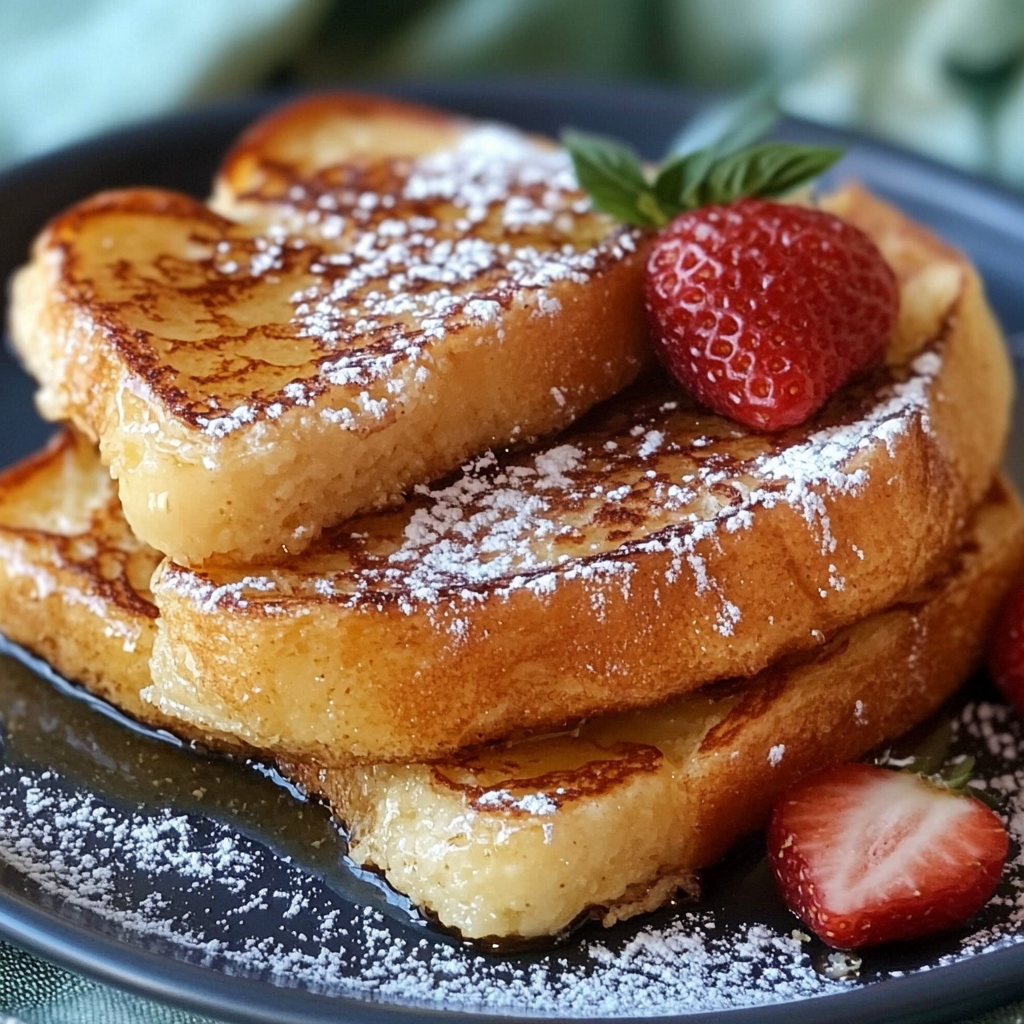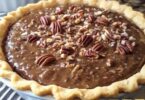Introduction
There’s something almost magical about waking up to the sweet aroma of Perfect French Toast sizzling on a skillet. It’s that golden-brown breakfast that makes any morning feel like a weekend. Whether you’re serving it for brunch with friends or enjoying a quiet breakfast with coffee, French toast is a comforting classic that never goes out of style.
In this detailed guide, you’ll not only find the exact ingredients and step-by-step instructions for making Perfect French Toast but also learn pro tips, variations, and serving ideas that will elevate your breakfast game.
Let’s dive in and turn your kitchen into a cozy breakfast café.
1. What Makes French Toast “Perfect”?
The Perfect French Toast is golden on the outside, soft but not soggy on the inside, and has that subtle hint of cinnamon and vanilla that makes every bite irresistible. It’s all about the balance — between crisp edges and custardy centers, sweetness and richness, simplicity and indulgence.
Think of it as the breakfast equivalent of a warm hug — comforting, familiar, and satisfying every single time.
2. The Secret Behind Choosing the Right Bread
The bread is your foundation. For Perfect French Toast, choose thick, sturdy slices that can hold up to soaking without falling apart. The best options include:
Brioche – rich and buttery, it’s a dream for classic French toast.
Challah – slightly sweet and eggy, perfect for an elegant twist.
Texas Toast – hearty and thick, holds the custard beautifully.
Avoid thin sandwich bread — it tends to turn mushy. Aim for slices about ½ inch thick for ideal texture.
3. Ingredients for Perfect French Toast
Here’s everything you’ll need:
8 thick slices bread (a hearty white bread, about ½″ slices)
1 ½ cups whole milk, warmed
4 eggs
3 tablespoons light brown sugar
½ teaspoon ground cinnamon
2 tablespoons unsalted butter, melted (plus extra for skillet)
¼ teaspoon salt
1 tablespoon vanilla extract
These ingredients come together to create a rich, flavorful custard that coats every slice perfectly.
4. Prep Time, Cook Time & Servings
Prep Time: 10 minutes
Cook Time: 25 minutes
Total Time: 35 minutes
Servings: 4
That means breakfast bliss for four happy people — or two very hungry ones!
5. Step-by-Step Instructions
1. Preheat oven to 350°F (175°C).
2. Place bread on a wire rack or baking sheet and bake for 7–8 minutes.
3. Flip and bake another 8 minutes.
4. Let cool for 5 minutes.
5. In a large bowl, whisk milk, eggs, sugar, cinnamon, melted butter, and vanilla.
6. Pour the mixture into a baking dish.
7. Soak bread for about 20 seconds per side.
8. Place on a baking sheet to prevent sogginess.
9. Lower oven to 200°F (95°C) to keep toast warm.
10. Melt butter in a skillet over low heat.
11. Cook slices 3–4 minutes per side until golden brown.
12. Transfer to oven to keep warm.
13. Serve warm with butter, powdered sugar, or maple syrup.
Enjoy your Perfect French Toast masterpiece!
6. Why Pre-Baking the Bread Matters
You might wonder — why bake the bread before soaking it?
Because dry bread absorbs custard better without getting soggy. By removing moisture through pre-baking, you create the ideal texture: crisp on the edges and tender in the center.
It’s the same principle as toasting a bun before making a burger — a little preparation goes a long way.
7. The Ideal Custard Mixture
The secret sauce of any Perfect French Toast lies in its custard. The combination of eggs, milk, vanilla, and cinnamon gives that smooth, creamy coating that transforms ordinary bread into breakfast heaven.
Whisk the ingredients thoroughly — you want a consistent texture so that every slice gets an even soak.
Pro tip: warm milk blends better with eggs and helps sugar dissolve smoothly.
8. How to Cook French Toast to Golden Perfection
Cooking French toast isn’t a race — it’s an art.
Use low to medium heat and a nonstick or cast-iron skillet. Add a bit of butter and let it melt completely before placing your soaked bread in.
Cook each side for about 3–4 minutes until golden and slightly crisp. Too high a temperature will burn the outside while leaving the inside undercooked.
Patience here makes all the difference between soggy and sublime.
9. Keeping Your French Toast Warm and Crispy
After each batch, transfer the cooked slices to a baking sheet in a 200°F (95°C) oven.
This simple step keeps your French toast warm and lightly crisp, perfect for serving family-style or entertaining guests.
Avoid stacking — that traps steam and makes the toast soft.
10. Best Toppings for French Toast
Now comes the fun part — toppings! Your Perfect French Toast is a blank canvas. Try:
Classic: Maple syrup, powdered sugar, and a pat of butter.
Fruity: Fresh berries, banana slices, or caramelized apples.
Nutty: Crushed pecans, almonds, or hazelnuts.
Indulgent: Whipped cream, chocolate drizzle, or Nutella.
Mix and match to create your own signature version.
11. Variations You’ll Love
Once you master the base recipe, try these creative twists:
Stuffed French Toast: Add cream cheese or fruit jam between slices before dipping.
Savory French Toast: Skip sugar and cinnamon; use herbs, cheese, and black pepper instead.
Overnight French Toast Bake: Layer everything in a dish, refrigerate overnight, and bake in the morning. Perfect for busy mornings!
12. Common Mistakes and How to Avoid Them
Even the best cooks make these French toast blunders:
Soaking too long: Bread becomes mushy.
High heat: Burns outside, leaves the middle raw.
Cold ingredients: Makes custard uneven.
Skipping pre-bake: Leads to sogginess.
Avoid these pitfalls, and you’ll nail the Perfect French Toast every time.
13. Pairing French Toast with Other Breakfast Items
To make it a full brunch spread, pair your Perfect French Toast with:
Scrambled or poached eggs
Crispy bacon or sausages
Fresh fruit salad
A cup of hot coffee or freshly squeezed orange juice
It’s the kind of breakfast that could easily impress anyone — from guests to your significant other.
14. Storage and Reheating Tips
Got leftovers? Lucky you!
Store: Refrigerate in an airtight container for up to 2 days.
Reheat: Pop in a toaster oven or skillet for a few minutes. Avoid the microwave — it softens the texture.
Freeze: Wrap each slice in parchment and freeze. Reheat straight from frozen at 350°F for 10 minutes.
15. Final Thoughts – Your Perfect French Toast Awaits
The Perfect French Toast is more than a recipe — it’s a tradition, a treat, and a reminder that the best moments often start at the breakfast table.
With a few quality ingredients, simple steps, and a touch of care, you can make café-quality French toast right in your own kitchen.
So grab that whisk, warm up your skillet, and get ready to make mornings unforgettable.
FAQs
1. Can I use almond or oat milk instead of whole milk?
Yes! Substitute any non-dairy milk for a lighter version. Whole milk just adds extra richness.
2. Why is my French toast soggy?
Most likely, the bread was too fresh or soaked too long. Use slightly stale bread and keep soaking under 30 seconds per side.
3. Can I make French toast ahead of time?
Absolutely. Cook, cool, and refrigerate. Reheat in the oven before serving for that just-made taste.
4. What’s the best syrup to use?
Classic maple syrup never fails, but honey or fruit syrups also pair beautifully.
5. How can I make my French toast extra fluffy?
Use thick bread slices and whisk a bit of air into your custard. Cooking slowly over medium heat also helps maintain fluffiness.
That’s your complete guide to Perfect French Toast — easy, delicious, and guaranteed to impress every single time.







